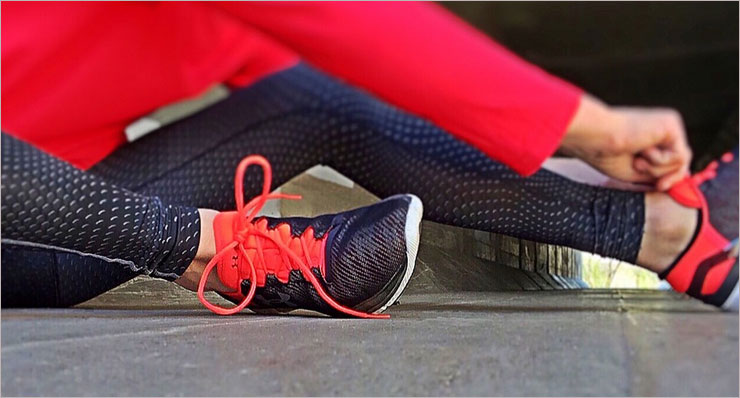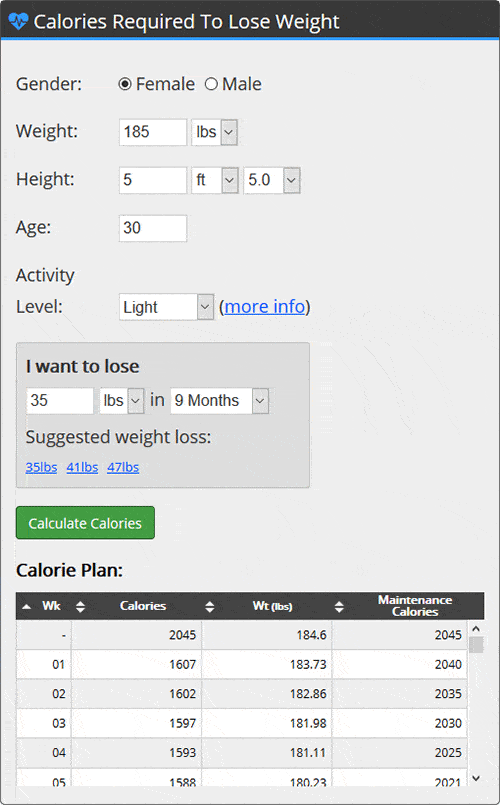How to Reduce 10 Kg in 20 Days
How Many Calories Should I Eat to Lose Weight?
The calorie calculator allows you to calculate how many calories you should eat a day in order to lose a certain amount of weight by a certain date.
Maximize your weight loss efforts by using the results from this calculator and apply them to this visual hack.
Getting results...
You have the following errors
Unfortunately an error has occurred, please try again!
Our Calories To Lose Weight Calculator
If you're wondering where to start when figuring out how many calories your body needs, it's best to begin with a basic calculation that has proven accuracy. The Mifflin-St. Jerome equation has been studied against many other calorie calculators and has come out on top according to the Jornal of the Academy of Nutrition and Dietetics.(1)
Our calculator incorporates the Mifflin-St. Jerome equation and uses the research based on the NIH Body Weight Planner and adapted from research collected at the National Institute of Diabetes and Digestive and Kidney Diseases. (2,3)
The calorie calculator is very useful for weight management as it displays how many calories are needed over the specified period of time. It keeps track of your weight loss and calories required. The less you weigh, the fewer calories you will need to take in for weight loss to continue. This is reflected in the calculator with the corresponding calories intake on a weekly basis.
For example : Assuming you are female, 5' 5", 170lbs at the start of August and would like to be 150lbs by Christmas, you would specify that you want to lose 20lbs in 5 months. The calculator will then give you your calories required on a week-to-week basis to reach your goal weight.
NB: Any (-ve) negative values are shown in red, ie trying to lose 50 pounds in 1 week is not possible. Values in yellow indicates a very low calorie intake. As a rule of thumb you should not eat below 1200 calories for female and 1600 calories for male.
How You Can Maximize Your Weight Loss
If you would like to maximize your weight loss efforts, use the results from this calculator and apply them to this visual hack. Using this one visual tool, you can help avoid the common pitfalls most people run into when trying to lose weight.
Combining the numbers generated by this calculator and adding them to a visual aid means you should have such a successful weight loss journey, you will want to share both the calculator and visual hack tool with your friends!
3 Ways To Reduce Calories
1. Exercise

Participating in regular exercise is very important. The American Heart Association recommends for adults to get about 150 minutes of moderate exercise or about 75 minutes of intense exercise (it's best to get some of both) throughout the week (4).
Exercising will keep you fit and burn excess calories, reducing your overall calorie intake. It can also be just as beneficial to incorporate incidental exercise throughout your day.
Change your everyday habits
This is a great way to offset some of the calories you take in through your diet:
- Choose the stairs rather than the elevator.
- Get off the bus, tram or subway a stop earlier and walk to your destination.
- Park your car at the far end of the carpark when doing your weekly shopping.
- Walk to the corner store for milk and bread rather than driving.
- Walk to the next office to speak with colleagues in person rather than sending an email.
Intense targeted workouts
Choose to 3-4 intense targeted workouts per week. Some good choices include swimming, circuit, cycling, running and weight training.
Another way to include high intensity, high calorie burning exercises into your week is to join a team sport which includes competition as well as training weekly.
Finally it's important to stay motivated. Reducing your calorie intake is hard. Take some time to look at your motivation. By writing down your motivation and your goals, you are more likely to stick to your calories and lose weight.
Losing weight is about cutting your overall calories. The fastest way to reduce calorie intake is to combine diet and exercise.
There are two important factors in reducing calories through diet.
2. Change Your Diet
Changing your diet is by far the most effective way to losing weight. Look at your current diet and make a change towards healthy and filling foods. Foods that are healthy and filling keep you fuller for longer, and mean that you reduce the amount of food and calories you are eating.
Your diet should include complex carbohydrates such as natural oatmeal, sweet potatoes and brown rice.
Vegetables (broccoli, spinach, green beans, cabbage, cauliflower, lettuce, radishes, asparagus, etc) fruits and salads should make up a large proportion of your diet.
Your source of lean protein should come from egg whites, chicken, turkey, lean red meat and fish (salmon, tuna, etc). Lean protein should be eaten with every meal.
These options should keep you full and help you to avoid overeating leading to a high calorie intake and weight gain.
Try to avoid fatty, deep fried, and foods full of sugar. These are high calorie foods without any nutritional value. They will increase your calorie intake without satisfying your hunger.
3. Reduce Your Portion Sizes
Often our portion sizes are much larger than we need. You should serve meals using a smaller plate. If there is more food than needed, put it away for another meal. It's much harder to have another serving if your leftovers have been portioned out for another meal.
Eat slowly. It takes some time for your body to register that you are full. If you eat quickly, you will eat too much food, and end up eating more calories than you need.
Don't eat if you aren't hungry and choose foods that keep you fuller for longer.
By drinking up to a litre of water before a meal, you will feel fuller and less likely to overeat.

How to Reduce 10 Kg in 20 Days
Source: https://www.healthyweightforum.org/eng/calculators/calories-required/